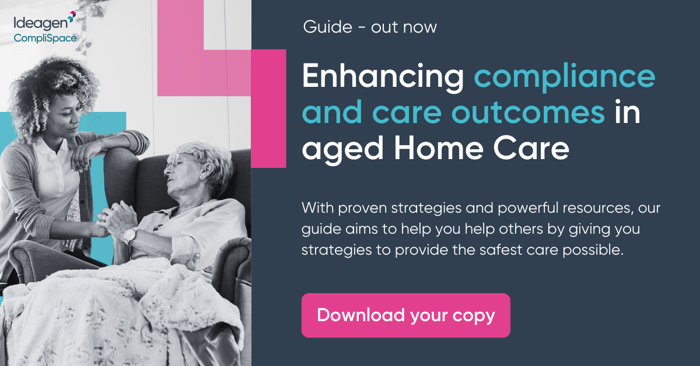Revised Aged Care Quality Standards will commence on 1 July 2024. Mostly, the new “strengthened” Standards will clarify and consolidate existing requirements, which means that aged care providers will be able to adapt their existing policies and procedures to address these requirements.
But in some areas, brand new requirements will be introduced, which means that providers will have to develop new policies and procedures. To help you prepare, we’ve summarised the new requirements.
Standard 1: The Person
1.1.2 – care that is culturally safe, trauma aware and healing informed
The provider must implement strategies to deliver care that is culturally safe, trauma aware and healing informed, in
accordance with contemporary, evidence-based practice.
Standard 2: The Organisation
2.2.2 – strategic planning to ensure services are accessible
As part of its strategic and business planning, the governing body is required to ensure that care and services are accessible to, and appropriate for, people with specific needs and diverse backgrounds, Aboriginal and Torres Strait Islander peoples and people living with dementia.
2.3.2 – monitoring investments
The governing body must monitor its investments in priority areas to deliver quality care and services.
2.3.4 – reporting to older people/families/carers
The provider must regularly report on quality system and performance to older people, families and carers.
2.8.2 – satisfied and psychologically safe workforce
The provider must implement strategies for supporting and maintaining a satisfied and psychologically safe workforce.
2.9.6 – training for workers
The provider must ensure that all workers regularly receive competency-based training in relation to core
matters, at a minimum:
- the delivery of person-centred, rights-based care
- culturally safe, trauma aware and healing informed care
- caring for people living with dementia
- responding to medical emergencies
- the requirements of the Code of Conduct, the Serious Incident Response Scheme, the Quality Standards and other requirements relevant to the worker’s role.
2.10.3 – engaging with older people/families/carers on disaster management planning
The provider must engage with older people, family, carers and workers about the emergency and disaster management plans.
2.10.4 – testing and reviewing disaster management plans
The provider must regularly test and review the emergency and disaster management plans in partnership with older people, family, carers, workers and other response partners.
Standard 3: The Care and Services
3.2.6 – system for caring for older people living with dementia
The provider must implement a system to identify and review the skills and strengths of people living with dementia and encouraging their use on a day to day basis.
3.2.8 – involving older people in selection of their workers
The provider must make reasonable efforts to involve the older person in selecting their workers (including the gender of, and language spoken by, workers providing care) and maximise worker continuity.
3.3.4 – matching older people to services; providing Care Statements
The provider implements processes to: correctly identify and match older people to their care and services; provide Care Statements to older people in residential aged care.
Standard 5: Clinical Care
5.1.4 – agreement on roles and responsibilities
The provider and health professionals must agree on their respective roles, responsibilities and protocols for providing clinical care – which is not included within the scope of the current requirements under Standard 8.
5.1.5 – digital clinical information system
The provider must work towards implementing a digital clinical information system.
5.3.2 – medication reviews
The provider must have processes to ensure medication reviews are conducted.
5.3.5 – reporting to the Therapeutic Goods Administration
The provider must have processes to report adverse medicine and vaccine events to the Therapeutic Goods Administration.
5.3.6 – reviews for safe and quality use of medicines
The provider must regularly review and improves the effectiveness of the system for the safe and quality use of medicines.
5.5 – Clinical Safety
(Although not entirely new, this section introduces a much more specific and detailed set of requirements compared with the current Standards, so we’ve listed it here as new)
The provider must implement a system that supports the identification, monitoring and management of high impact and high prevalence clinical care risks, including but not limited to:
- Choking and swallowing
- Continence
- Falls and mobility
- Nutrition and hydration
- Mental health
- Oral health
- Pain
- Pressure injury and wounds
- Sensory impairment
Standard 6: Food and Nutrition
The classification of food and nutrition as its own separate Standard is new. However, some of the requirements within the Standard are not new. These requirements replicate or clarify content from the existing Standards and include familiar requirements such requirements to: undertake assessment and planning for consumers’ needs, conduct risk management and provide varied meals of suitable quality and quantity.
That said, the Food and Nutrition Standard introduces several new requirements that are much more specific than the requirements in the current Standards:
6.1.1 – partnering with older people
The provider must partner with older people on how to create enjoyable food, drinks and dining experience at the service.
6.3.1 – menus
Providers must develop and review of menus, in accordance with new requirements and in partnership with older people and relevant health professionals.
6.3.2 – choice
Providers must ensure that, for each meal, older people can exercise choice about what, when, where and how they eat and drink.
6.3.4 – access to snacks and water
Providers must ensure that older people are offered and able to access nutritious snacks and drinks (including water) at all times.
6.4.3 – sharing meals with visitors
Providers must ensure that there are opportunities for older people to share food and drinks with their visitors.
What Providers Need to Do
In addition to the work of adapting their existing policies and procedures to the new Standards, providers should:
- Audit their policies and procedures against the new requirements: have you addressed the new requirements? Where in your policies could you add new sections? Do you need some entirely new policies?
- Draft or outsource the drafting of your new policies.
- Organise for team leaders/board to review new policies.
- Train staff on the new policies.
- Inform older people, their authorised representatives, families, carers and other stakeholders of new policies.
More Information






